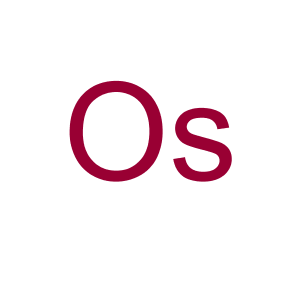Title: Osmium
CAS Registry Number: 7440-04-2
Literature References: Os; at. wt 190.23; at. no. 76; valences 1-8; most common states 3, 4, 6. Group VIII (8). Seven naturally occurring isotopes: 184 (0.02%); 186 (1.6%); 187 (1.6%); 188 (13.3%); 189 (16.1%); 190 (26.4%); 192 (41.0%); artificial radioactive isotopes: 181-183; 185; 191; 193-195. Occurrence in earth's crust ~0.001 ppm. Found in the mineral osmiridium and in all platinum ores. Discovered by Tennant in 1804. Prepn: Berzelius
et al., cited by Mellor,
A Comprehensive Treatise on Inorganic and Theoretical Chemistry 15, 687 (1936). Reviews of prepn, properties and chemistry of osmium and other platinum metals: Gilchrist,
Chem. Rev. 32, 277-372 (1943); Beamish
et al. in
Rare Metals Handbook, C. A. Hampel, Ed. (Reinhold, New York, 1956) pp 291-328; Griffith,
Q. Rev. Chem. Soc. 19, 254-273 (1965);
idem, The Chemistry of the Rarer Platinum Metals (John Wiley, New York, 1967) pp 1-125; Livingstone in
Comprehensive Inorganic Chemistry vol. 3, J. C. Bailar, Jr.
et al., Eds. (Pergamon Press, Oxford, 1973) pp 1163-1189, 1209-1233.
Properties: Bluish-white, lustrous metal; close-packed hexagonal structure. d420 22.61; long believed to be the densest element; x-ray data show it to be slightly less dense than iridium. mp ~2700°. bp ~5500°. Sp heat (0°) 0.0309 cal/g/°C. Hardness 7.0 on Mohs' scale. Electrical resistivity (0°) 8.12 mohms-cm. Stable in air in the cold; when finely divided, is slowly oxidized by air even at ordinary temp to form tetroxide. Attacked by fluorine above 100°; by dry chlorine on heating; not attacked by bromine or iodine. Attacked by aqua regia, by oxidizing acids over a long period of time; barely affected by HCl, H2SO4. Burns in vapor of phosphorus to form a phosphide, in vapor of sulfur to form a sulfide. Attacked by molten alkali hydrosulfates, by potassium hydroxide and oxidizing agents. Finely divided osmium absorbs a considerable amount of hydrogen.
Melting point: mp ~2700°
Boiling point: bp ~5500°
Density: d420 22.61
Derivative Type: Osmarins
Literature References: High-molecular weight polymers of carbohydrate and osmium. Potential use in the treatment of arthritis:
Chem. Eng. News 60, 8 (April 5, 1982).
Use: As alloy with iridium for pen points and fine machine bearings; as catalyst in the synthesis of ammonia; as catalyst in hydrogenation of organic compounds.

